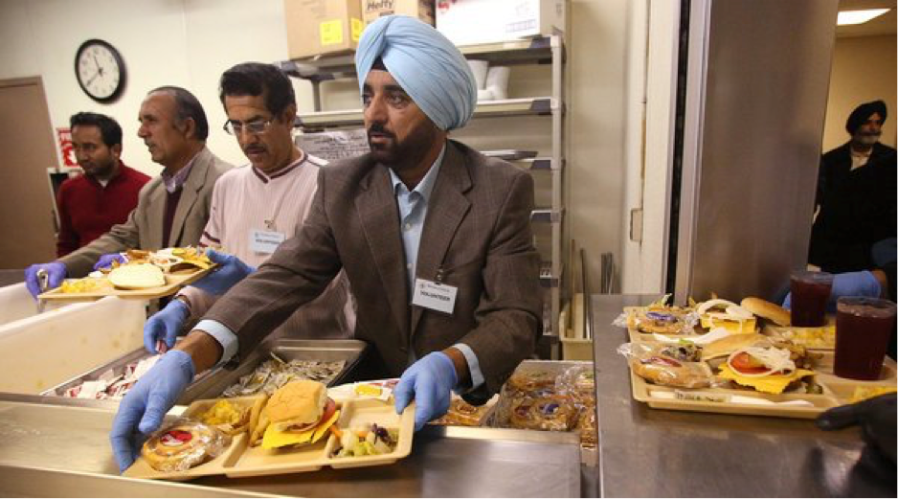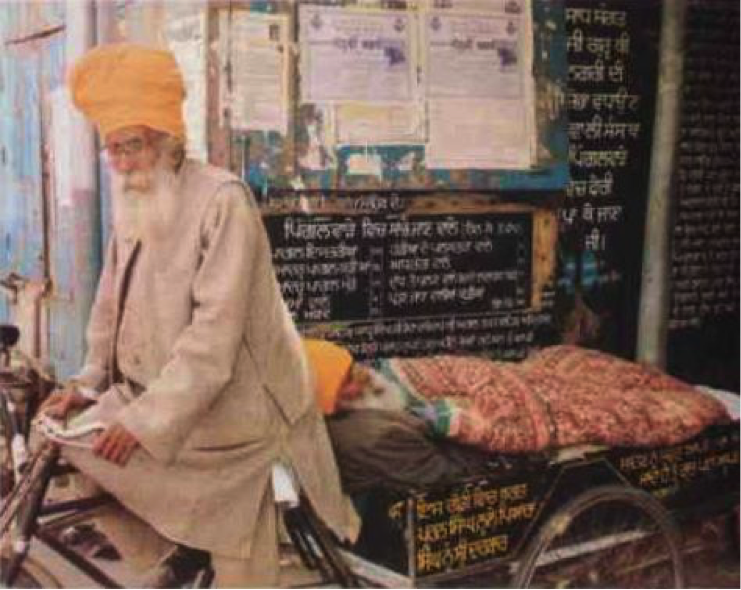By Harbans Lal, Ph.D., D.Lit. (Hons).
Being male or female is a matter of birth. Being a man or a woman is a matter of gender. Being old or young depends on one’s date of birth. However, being a Wisdom Seeker (translated into the Punjabi language as “Sikh”) is a matter of choice. It does not require preaching, promoting, or blasts from the media.
I spent a significant portion of my life practicing Pharmacology and Neuroscience at medical institutions. Many in my field knew me and my work. I rarely had to tell anyone about my identity as a pharmacologist or a neuroscientist. They knew who I was from my work, my education, my research, and most of all my daily interaction with them.
I have taken the liberty of citing my own example, at the risk of being impolite, but there are numerous other examples. For example, I do not have to name someone like Albert Einstein. Among Sikhs I do not need to announce credentials of Sikhs like Narinder Singh Kapany, Prime Minister Dr. Manmohan Singh, Bhai Mohinder Singh of Guru Nanak Nishkam Seva, Dr. Inderjit Singh OBE, or scholar/writer Dr. IJ Singh among many many. They never hired an advertising agency to tell others who they were. People know them by their work, from their accomplishments, and above all from interaction public.
Besides our Sikh contemporaries, I recall many great Sikhs from the recent past as well. Is anyone ignorant about the religion of Bhagat Puran Singh, Bhai Chelaram, Sant Bhidranwala, Professor Puran Singh, Bhai Hira Singh Ragi, or many others?
Then why is it that our Sikh institutions today have to organize programs, publish pamphlets, sponsor lecture tours, hire media firms, or even go to court just to make our neighbors know who we are? Why do we put up billboards at substantial cost, just to articulate to those we deal with every day that we are Sikhs?
Why do we not become Sikh and act like one? The fact that Sikhs today do not stand out as Sikhs says something serious about the disconnect between our kehni and karni (words and deeds).
SEVA FOOD BANK

Recently the answer flashed in my mind. Kulvir Singh Gill was in Dallas the other day to speak at a fundraising event for Sikh Research Institute. In his powerful presentation, he detailed the Seva Food Bank, an organization he co-founded in the greater Toronto area. He told us that he gave no sermons to people who came for food, or to those Canadians who came to him to offer help in volunteering, or even to offer financial gifts. He described how the Canadian public soon came to know who the Sikhs were without the requirement of billboards and advertisements. Serving in the Food Bank was the secret.
 Gill cited an example of being a “gentleman” in his speech. He said if an individual has to go around telling people he is a “gentleman”, he is probably not a “gentleman”.
Gill cited an example of being a “gentleman” in his speech. He said if an individual has to go around telling people he is a “gentleman”, he is probably not a “gentleman”.
Some time ago, I saw a sign in a restaurant that said something like “In American society, a “gentleman” will exhibit love and respect for his friends. Often he will do so not because his friend was helpless or unable. However, because he is a “gentleman” and he wants to show his guest that she is valuable and worthy of respect.”
It is obvious that none of them will have to tell that they are “gentlemen” or intelligent men. The attitudes and actions in the public alone are effective to deliver the message.
SIKH IS A VERB
Some time ago, I wrote an article about whether the term “Sikh” was a noun or a verb. There I discussed how the word “Sikh” could be both at different times of the day depending upon whether s/he is being a Sikh at that moment or not.
When Guru Nanak traveled to new places, he never revealed what his religion was, or what would be the religious label applied to those who began to follow him. Eventually, those communities became known as Sikhs (wisdom seekers) because they were coming to the Guru seeking his wisdom. The same wisdom later came to be known as Gurmat or the Wisdom of the Guru. Sikhs always lived by Gurmat in their life practices and were prominently known to their neighbors.
I work with interfaith organizations and programs in North Texas area. Among my colleagues, the audiences at my presentations, or those I meet socially, no one asks me about my faith affiliation. They all know me as a Sikh. Some time ago, when I was in the hospital for surgery, the clergy from 22 faith traditions prayed for me. I am confident that many others could report similar experiences.
Sikhi is a dynamic virtue, and our neighbors are bound to perceive it as so. This could be rendered into English as “are called Sikh”. It would make a nice little exercise to investigate this point more thoroughly than I have done. I did write a lengthy article some time ago titled – Is Sikh a Noun or Adjective. Now I think it might even be a Verb.
GURU NANAK’S METAPHOR OF A RIVULET
I had also written earlier that the Guru Granth termed Sikhi as a “rivulet” perhaps because a “rivulet” carries water from the ocean via snow and rains to fertilize diverse lands continuously. It serves surrounding communities, and it does not require any media firm or extensive marketing to tell the neighborhood that it was a rivulet. They will not escape noticing its life giving contribution to its neighborhoods.
The verse goes like this.
ਗੁਰੂ ਸਮੁੰਦੁ ਨਦੀ ਸਭਿ ਸਿਖੀ ਨਾਤੈ ਜਿਤੁ ਵਡਿਆਈ ॥ SGGS, p. 150
The Guru, the Divine Wisdom, is the bottomless ocean, and all of its WISDOM is in the form of teachings that originate out of this ocean, as rains and falling ice give birth to countless rivulets and rivers, sometimes puddles, of many lengths and depths. When drenched with these rains and rivulets, the earth is fulfilled. Those who are drenched in the Guru’s ways are exalted and grateeful.
METAPHOR OF FRAGRANCE
 The Guru Granth also describes Sikhi using the metaphor of fragrance. In this verse from sacred scripture, Guru Nanak explains his doctrine for living: this way:
The Guru Granth also describes Sikhi using the metaphor of fragrance. In this verse from sacred scripture, Guru Nanak explains his doctrine for living: this way:
ਨਾਉ ਨੀਰੁ ਚੰਗਿਆਈਆ ਸਤੁ ਪਰਮਲੁ ਤਨਿ ਵਾਸੁ ॥ SGGS, p. 16
Spread your irresistible fragrance produced from cleansing the mind and the body with waters of Goodness, followed by application of the scented oil of Truth.
The metaphor of fragrance in Sikhi is a powerful one. As Marian Bendeth said, “Fragrance speaks the loudest on a subliminal level.” Another wise man, Sheikh Saadi wrote, “Mush Anast Keh Khud Baboyad Na Keh Attar Baboyad”. He emphasized that the fragrance is capable of selling itself, along with the source that emits fragrance. Because it has inherent allure, the fragrance requires no trader, no sales force or media, to announce its presence. If it did, it was not fragrant.
In the silence of your room, in the hubbub of the melee, in the busy current of your routine, or in crises, there is surely value in reflecting on what your faith might mean at that moment. When you are comfortable with your own answer, all those surrounding you will know what your faith is, and what your commitment to it is. You will not have to go to any great length to explain your faith to anyone.
TAKE HOME MESSAGE
A reputation is built on what you have done, not what you have promised to do. Our current obsession with telling the world what Sikhs are is a largely fruitless exercise, and perhaps a reflection of our inability, individual and collectively, to live up to the values our Guru has given. Identifying ourselves as Sikh (or even looking like one) is largely a pointless label unless one is working towards living Sikh values– that is, our Sikhi. Otherwise, it is as if we are wearing a Halloween costume all year round (and fooling no one).
Sikhi is to be lived and is to be experienced. Our actions, not our words, need to validate our values (i.e.” gentlemen” analogy). To understand the dynamics of identifying, being and doing, from a Sikh perspective, the concept of a rivulet and of the fragrance are powerful metaphors used by Guru Nanak.
Indeed, there is much ignorance, which is leading to unnecessary fear and dangerous hate. So yes, we need to increase awareness of Sikhs and Sikhi in the public. However, “how” is the critical question?
TO BE SEEN DOING GOOD WORK IS MUST
Kulvir Singh’s first workplace mentor told him that to be successful one needs to do good work but also been seen doing good work. With that in mind, let us focus first on living our Sikhi in private (when no one is watching) and then in public (when the eyes of the world are on us). If our kehni and karni (words and deeds) are aligned, then accolades and awareness will be a natural consequence.

Bhagat Puran Singh, an octogenarian Sikh, carried the sick and disabled on his tricycle driven cart to their place of treatment or care center. His Sikhi was noticed very widely.
Send all communications to:
Harbans Lal, Ph.D.; D.Litt (Hons)
Professor Emeritus & Chairman, Dept of Pharmacology & Neurosciences, University of North Texas Health Science Center.
Professor Emeritus, Guru Nanak Dev University, Amritsar, India.
President, Academy of Guru Granth Studies.
web: https://seekingwisdomblog.wordpress.com
email: Japji2050@gmail.com
Please join my mailing list. I’ll use your email address from time to time to send you newsletters and other information.

This is an information age. Today the volume and the speed of information flow at much higher rate than ever before in the past. In one minute time, computers and technology can move more information before our eyes than the total information known to humans since the discovery of the written world until the end of the last century. We are all competing for time and space on the information highway. If we do not seek time or space to tell our story about our philosophy, the purpose for our existence, our way of life, and what we believe in, then, we will be completely overwhelmed by other religious beliefs and thoughts, thus, strangulating our reasons for our existence. We owe it to our children that the good work and teachings of Guru Nanak and his followers must be adhere to and understood within the framework of an honest living, doing an honest work, rendering selfless service, promoting just society, respecting human rights, sharing commonwealth, and fulfilling our contractual
obligations. We must secure some time and space to relay our message on the information highway. To this end, we need the support of all good people capable of leading us on this journey.
Sat Nam,
Thank you very much for your always thoughtful articles, Yes, I agree that Feeding the Hungry and those in need, is a best way to ‘leave Guru’s fragrance’ in this busy age. Living one’s life so that others know through you and your deeds – who or what do Sikhs believe and do, is why Guru gave us His Roop, so we stand out – one way we remind ourselves daily who we belong to, and to others – ‘who will help’ in times of need. I also agree that it is critical to use the tools of this busy – electronic media, as you do with this blog, and other means of public and community relations tools. Many of our Sikh organizations, since the turn of the century, and the challenges after NYC 9/11, realized that the lack of awareness and education on Who are Sikhs? by the general public, is a great risk to the safety of our communities. This is born out in hate crime statistics. Disseminating information and education about Sikhs to the public, such as public service announcements, articles, and other ways you mention, are key options providing awareness of Sikhi to more people faster. Sikh educational information ‘tools’ and news – to go into schools, churches, state houses, public safety offices, federal agencies, and many other critical focal points, and share informative data about Sikhs to large numbers of the public, is an important service to help collectively show who we are. Dissemination of seva ideas, for repetitive use in other communities, is a great help when we organize in our own Sikh Sangats, our communities. It is often inspiring to see how another Sikh community organized a Sikh Awareness Day, or Turban Awareness Day at their University, or State Legislature. We’ve seen Sikhs feed the Hungry, from our basic teaching of Langar appear in so many places – local communities taking up the seva from the neighborhood to Congress. Here in NM, the Food 4 Kids backpack program serves over 400 children now – every weekend providing a kid-friendly food bag to last a child throughout the weekend, (http://food4kidsnm.org/) when their households are deemed food insecure. I think is incumbent upon us to reach out to our own Sikh diaspora and the general public and use the many tools to inspire, uplift, and assist understanding of who we are, what we do, and Guru Ji’s Divine message for humankind. Wahe Guru. Thank you.
Thank you Harbans Lalji. Your article goes deep inside and reminds us to be our Gurus’ true Sikhs in word and action.This is what our Guru Sahabs had envisaged their Sikhs to be.
Your article has given me so much hope….its great to know we still have Sikhs like you who follow Guru Nanak Dev ji’s Sikhism…..hope that we will be able to fight and win this battle against the dogmatic clergy. A clergy that is imposing their own diktats as to who is a Sikh and who is not….who and what has to be done in a Gurdwara. So much of ritualistic routine has been introduced in our Gurdwaras they seem to have forgotten that our Gurus did not believe in ritualism.
Dr. Harbans Lal ji, I am delighted to read your in depth analysis of the word ‘Sikh’, and the meaning od the word as a ‘verb’, besides being a ‘noun’ and an ‘adjective’. The metaphos of FRAGRANCE and RIVULETS , used by Guru Nanak, in SGGS, are particularly convincing to the mind.
I am fortunate to have personally interacted with you when almost two decades ago your good self had accompanied my uncle, Late Dr. Beant Singh, to our house in Chandigarh. I would like to be in your mailing list and my mailing details are being sent separately. Sat Sri Akal.
The article may be good in literary or academic sense. With due respect to the writer, he may not be aware of the fact that people lost lives here in US due to the ignorance about Sikh religion. So every effort is needed
Great article. Yes, one can be good human by doing good deeds but unless one do not have turbun and uncut Kesh one can be related as great person (Gentleman) not a Sikh. Idea of keeping kesh has very deep psychological, philosophical and spiritual meaning beyond scope of ongoing discussion. Now one can say being good human is not enough in this life? Yes for some but Sikh goes farther to be one with Har jee. (Akal Purakh).
Doing great stuff and no Sikh dress can make a person a good Human but it will not tell other if he is a Sikh. Being good human is subset of few values which Sikh also have but Sikhi is super set (Naam).
Sikh wears uniform and also do good deeds and use all kind of avenue to tell others what he believe in as Guru Nanak Sahib did by going to four Udasis. Also I would like to add Guru Nanak Sahib as well Mardana Sahib both had Sikh appearances when they went ahead and tried to spread his message which was later called Sikhi.
Admittedly dr Harland Lal ji is a very respected voice in the Sikh circles.
While agreeing with his analysis on one plane, I respectfully disagree with him on another plane. For the Sikh diaspora to ignore the ignorance in USA can cost limb n life. We have to aggressively project ours selves here
How can we ignore the Wisconsin gurudwara attack
Excellent discription of SIKH and SIKHI